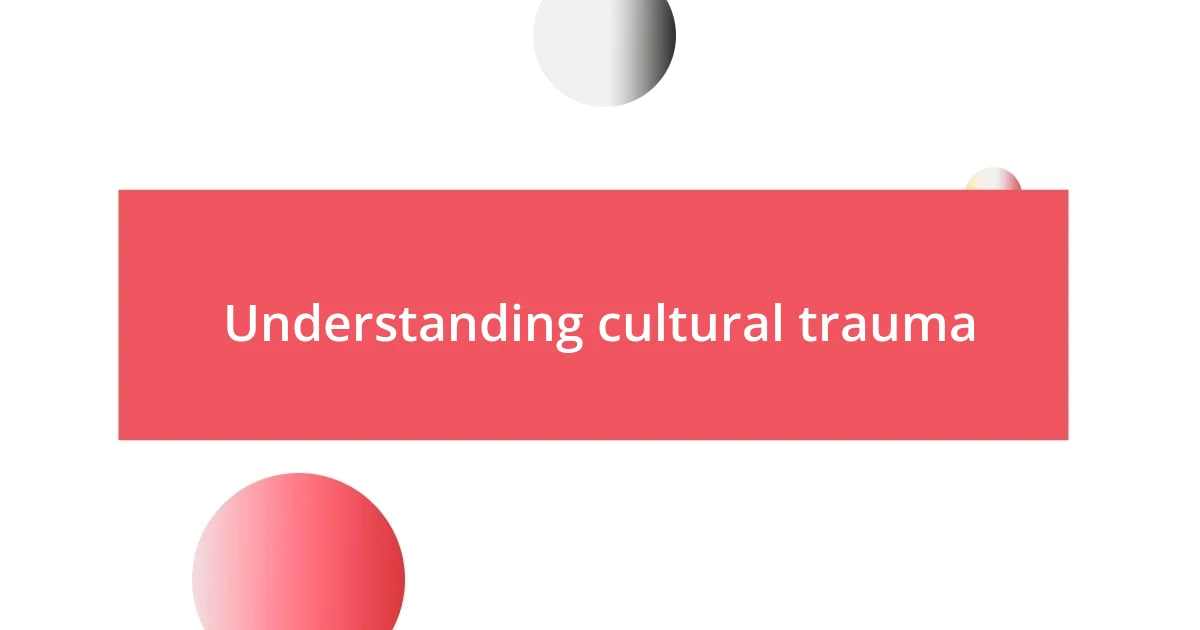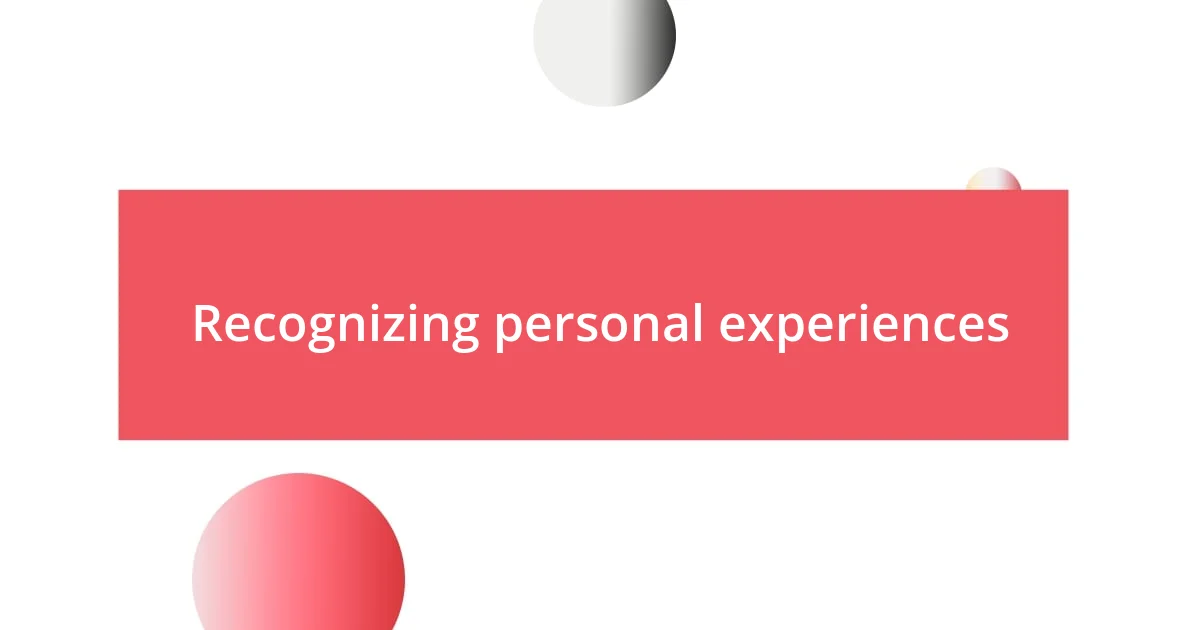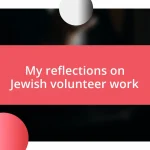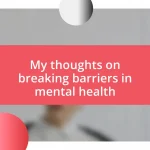Key takeaways:
- Cultural trauma impacts individuals and generations, shaping identities and emotional landscapes through shared pain and resilience.
- Recognizing personal experiences and fostering community support networks are crucial for healing, enabling connections through storytelling and mutual understanding.
- Healing practices, such as traditional rituals and art, play a vital role in reclaiming cultural identity and enhancing emotional recovery and resilience within the community.

Understanding cultural trauma
Cultural trauma is often an invisible thread woven into the fabric of a community, and it can shape individual lives in profound ways. I remember a friend of mine who described the weight of his ancestors’ experiences as if they were stones in his backpack—he felt them with every step he took. This perspective makes me wonder: How many of us carry these stones, often unaware of their origins or impact?
One powerful aspect of cultural trauma is its generational nature. It doesn’t just affect those who experience the trauma directly; it seeps into the memories and emotions of future generations. I often think about how my own family’s struggles with societal discrimination have colored my views and relationships today. Isn’t it fascinating—and slightly terrifying—how shared pain can shape our identity in ways we may not even realize?
Understanding cultural trauma also means acknowledging the resilience that often emerges from it. I’ve witnessed communities come together to heal, transforming their shared pain into collective strength. This makes me ask: What if we viewed our cultural wounds not just as scars, but as the beginnings of a healing narrative that connects us? It’s a thought that leaves me hopeful, reminding me that while trauma is deeply ingrained, it can also pave the way for healing and understanding.

Recognizing personal experiences
Recognizing personal experiences is a crucial step in understanding how trauma influences our lives. I remember the moment when I sat down and reflected on my childhood memories. I realized that many of my fears and anxieties stemmed from family stories that were ever-present in our conversations. It was like peeling back layers of a complex onion, revealing how deeply my emotions were intertwined with my cultural history.
- Identifying triggers: Certain places, conversations, or events can evoke powerful emotions tied to past traumas.
- Inviting vulnerability: It’s essential to feel safe enough to share these experiences within our communities.
- Connecting to others: Sharing personal stories can help build understanding and solidarity among those with similar backgrounds.
- Embracing healing: Acknowledging our experiences allows us to confront and ultimately transform them into sources of strength.
I find that the more I speak openly about my journey, the more empowered I feel. It’s like shining a light on the shadows of my past, illuminating understanding and, ironically, forging deeper relationships. Each story shared becomes a step toward healing, not just for me, but for those who resonate with my narrative.

Identifying the impact of culture
Identifying the impact of culture on our individual experiences is essential for understanding how trauma reverberates through our lives. I recall a friend sharing her experience of feeling disconnected from her cultural roots while growing up in a predominantly different society. This sense of alienation not only affected her identity but also unintentionally amplified feelings of loneliness and despair. It’s remarkable how cultural disconnection can propagate emotional trauma that lingers long after the initial event.
What intrigues me about culture is its dual nature—it can both nurture and wound. During a community gathering, I watched as elders shared stories of resilience, courage, and deep sorrow. Their narratives painted a vivid picture of a rich heritage filled with both achievements and heartbreaks. This blend of pride and pain highlighted how culture shapes our emotional landscapes, advocating for a balanced understanding of our shared histories. Isn’t it fascinating how those stories can resonate with your own experiences, creating both a sense of belonging and a confrontation with unresolved pain?
It’s not just the past that casts a shadow over us; cultural expectations can also create pressure that feels overwhelming. I often feel this when I’m caught between traditional values and contemporary views. For instance, my family’s expectations regarding career choices often clash with my personal passions. Each time I navigate this tension, I realize it magnifies my internal struggles—a reminder of how culture acts as both a guide and a burden. Understanding these impacts inspires me to engage with my cultural identity more thoughtfully, ultimately fostering a healthier relationship with my past and present.
| Positive Impacts of Culture | Negative Impacts of Culture |
|---|---|
| Community support and shared narratives | Alienation and disconnection |
| Resilience and strength from shared histories | Pressure from cultural expectations |

Healing practices within my culture
Healing practices within my culture are deeply woven into the fabric of our community. I often find solace in traditional rituals that encompass both physical and spiritual aspects of healing. For instance, during a recent healing ceremony, I watched as the shaman burned sage, the fragrant smoke swirling around us, creating a sacred space for reflection. It’s moments like these that remind me of the power of collective energy—there’s something undeniably uplifting when we come together to support each other in times of need.
Another healing practice that resonates with me is storytelling. You’d be surprised at how sharing narratives can be transformative. I remember sitting around a fire with friends, recounting personal experiences while sipping herbal tea. Each story shared felt like stitches being woven into a shared quilt of healing. It’s not just about the tales themselves; it’s about the connections we forge and the understanding we cultivate. Have you ever felt lighter after sharing your burden with someone? That’s exactly the kind of relief I experience during these gatherings.
Furthermore, the integration of art into healing cannot be overlooked. In my community, creating is often a form of therapy. I recall painting a mural that portrayed my journey through trauma, each brushstroke expressing emotions I could hardly articulate otherwise. Engaging in creative expression allowed me to process my feelings while also sharing pieces of my culture with others. Isn’t it empowering how art bridges our inner experiences with the outer world? Through these healing practices, I not only reclaim parts of myself but also discover deeper layers within my cultural identity that continue to shape my healing journey.

Building community support networks
Building community support networks is crucial for navigating the complexities of trauma within any culture. I remember feeling utterly lost during difficult times, yet the simple act of reaching out to others was transformative. I found kinship in a support group where individuals shared their own experiences, and it was as if our collective stories created a safety net, catching us when we stumbled. Isn’t it amazing how much strength lies in shared vulnerability?
In my experience, it’s essential to foster an environment where members feel both seen and heard. I’ve participated in community workshops that encourage open dialogue about our struggles. Each time someone bravely steps forward to share their story, the room fills with empathy and connection. It’s like witnessing a ripple effect; one person’s courage inspires another, making us all feel less isolated. Have you ever felt a sense of relief just by knowing someone else understands your pain?
Moreover, I’ve noticed how cultural events can serve as a backdrop for building these vital networks. One memorable example was our annual cultural festival, where various generations gathered, sharing not just food, but also their stories. As we laughed and reminisced together, bonds formed, helping us navigate our unique traumas as a united front. These moments highlighted an undeniable truth: community support is not merely a safety net; it’s a lifeline that thrives on the richness of our shared experiences. How can we harness this power to uplift one another in times of need?

Sharing stories for empowerment
Sharing stories can be a profound act of empowerment. I recall a moment when a close friend opened up about her struggles during a group gathering. As she recounted her experience, I could see the weight lifting from her shoulders. It struck me how her bravery resonated with everyone present. Suddenly, one by one, members began to share their own narratives, creating a tapestry of shared strength. Isn’t it incredible how vulnerability can spark courage in others?
In another instance, after a particularly challenging day, I attended a storytelling event within my community. The atmosphere was electric with anticipation; each person brought their layered experiences to the table. I shared a piece of my past, hesitating at first but finding my voice amidst the warmth of supportive nods. The feedback was overwhelming—people reached out to connect over similar experiences, and it felt like I had opened a door to healing for us all. Have you ever felt understood in a way that cracked your heart wide open?
Reflecting on these moments, I realize that storytelling is more than just sharing; it’s about forging connections that can break down the barriers of loneliness. A gentle reminder of how important it is to weave our personal and cultural narratives together. When I think back to those evenings around the fire, I feel a glow of empowerment—not just for myself but for our entire community. We are stronger for sharing our truths, and through these stories, we create a legacy of resilience for those who come after us.

Navigating recovery and resilience
Navigating recovery and resilience often requires a deep dive into our emotions. I vividly remember a moment during therapy when I confronted a painful memory tied to my cultural background. The room felt heavy, yet as I spoke, I felt an unexpected release. It’s fascinating how acknowledging our pain can actually forge connections with our inner strength. Have you experienced that moment when confronting a tough memory felt more like reclaiming a part of yourself?
Building resilience is not a solo endeavor; it thrives in the company of others. During a recent gathering, I felt a shift in energy as we engaged in a group meditation rooted in cultural practices. The experience was surreal as each person’s breath aligned, uniting us in a shared space of healing. It made me think about how collective practices can elevate individual journeys. Isn’t it remarkable how community can bolster our ability to bounce back?
Moreover, I’ve learned that resilience is also about celebrating small victories along the way. After completing a personal goal, I felt the urge to share my success with my friends, who had been supportive throughout my struggles. Their joy in my accomplishment made me realize that these moments are the threads that weave resilience into our lives. Have you ever paused to appreciate how far you’ve come, even in the midst of challenges? Embracing these milestones can remind us of our capacity to heal and grow, together.















